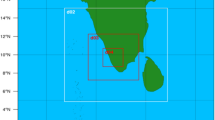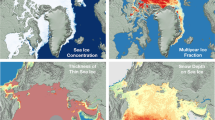Summary
The electromagnetic radiation of cloud discharge known as atmospheric radio noise field strength (ARNFS) shows a gradual fall from a frequency of 9 kHz to 81 kHz as studied over a period of two years at Calcutta, very close to Bay of Bengal. The main characteristic features of ARNFS at Calcutta are that-(i) ARNFS shows that midday median value is smaller than midnight median value in all months, (ii) level of daily minimum is higher in February and monsoon compared to other seasons, (iii) ‘sunrise effect’ and ‘sunset effect’ are well correlated with local sunrise and sunset times, (iv) the magnitude of ‘sunrise fade’ and ‘sunrise fade rate’ are maximum in April and lowest during winter period, (v) the magnitude of sunset fade is higher in premonsoon and postmonsoon while it is lowest in monsoon, (vi) number of occurrence of both sunrise effect and sunset effect is remark-ably smaller in monsoon. The positions of the sun and of atmospheric sources are jointly the causes of seasonal and diurnal variations. The missing of ‘sunrise effect’ and ‘sunset effect’ are due to local cloud activity and variation of electron density during geomagnetic storms.
Similar content being viewed by others
References
Berger, K., 1978: Blitzstrom-Parameter von Aufwärtsblitzen.Bull. Schweiz. Elektrotech. Ver.,69, 353–360.
Cowley, S. W. S., Morelli, J. P., Lockwood, M., 1991: Dependence of convective flows and particle precipitation in the high latitude dayside ionosphre on the X and Y components of the interplanetary magnetic field.J. Geophys. Res. 96, 5557–5564.
De, B. K., Sakar, S. K., 1986: Effect of geomagnetic storms on sunrise fade of long distance 40 kHz propagation.Meteorol. Atmos. Phys.,35, 227–235.
Friedel, R. H. W., Hughes, A. R. W., Dowden, R. L., Adams, C. D. D., 1993: First observations on Trimpi events at Durban (L=1.69) using a OMSKI receiver.J. Geophys. Res.,98, 1571–1580.
Hara, T., Horiai, K., 1979: Geomagnetic disturbances and associated phase anomalies of VLF radio wave at middle latitudes.J. Geomagn. Geoelectr.,31, 75–85.
Hayakaya, M., Shimakura, S., 1978: On the mechanism of reflection of ELF-LF radio waves from lower ionosphere.Trans. IECE Japan,E61, 15–18.
King, J. W., Fooks, L., 1968: Long lasting storm effect in the ionospheric D region.J. Atmos. Terrest. Phys.,30, 639–643.
Sarkar, S., Bhattacharya, A. B., Sen, A. K., 1980: On the seasonal variation of VLF atmospherics and rainfall over Calcutta.Ann. Geophys. 80, 67–72.
Satori, G., 1991: Combined ionospheric effect due to Forbush decrease and magnetospheric high energy particles at mid latitudes.J. Atmos. Terr. Phys.,53, 325–332.
Author information
Authors and Affiliations
Additional information
With 7 Figures
Rights and permissions
About this article
Cite this article
De, B.K., Sarkar, S.K. Regular and seasonal behaviour of atmospheric radio noise field strength (ARNFS) over low latitude station calcutta. Meteorl. Atmos. Phys. 61, 107–114 (1996). https://doi.org/10.1007/BF01029715
Received:
Revised:
Issue Date:
DOI: https://doi.org/10.1007/BF01029715




